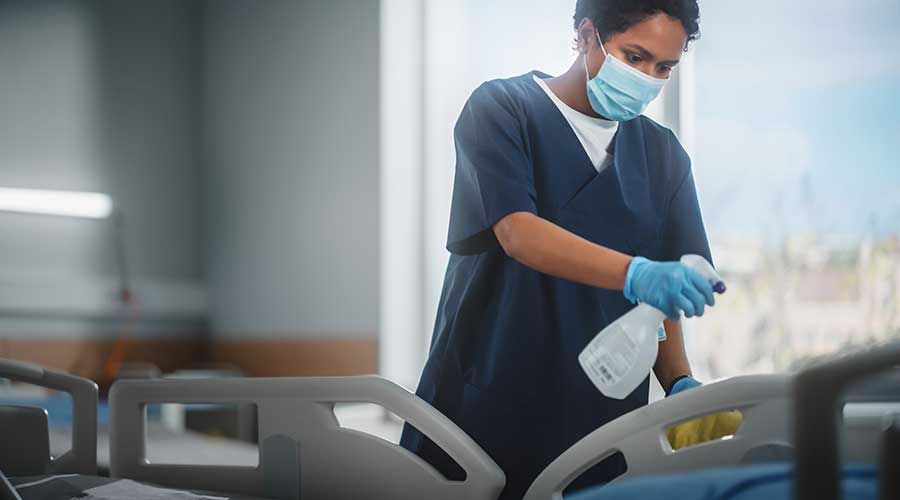The latest data from the Centers for Disease Control and Prevention (CDC) show alarming increases in the most dangerous superbugs. Year over year, Acinetobacter is up 78 percent, Candida auris is up 60 percent, and the notorious methicillin-resistant Staphylococcus aureus (MRSA) is up 13 percent.
In 2015, the MedEra report shined a light on the full societal costs of such infections, which are more inclusive than commonly reported direct hospital costs, which have never been fully measured or reported.
The report analyzes updated figures from the CDC — $28 billion-$45 billion related to healthcare-associated infections (HAI) among hospital inpatients. It also estimated the economic burden of HAIs in acute care hospitals to be $96 billion-$147 billion, which included the cost of incrementally consumed clinical resources, as well as the value of lost workdays, graduated for both men and women, and life years.
There is enough evidence to demonstrate that cleaning hospitals and other healthcare facilities helps prevent infections. Yet the cleaning staff is often untrained, unmotivated, underpaid and underappreciated. Coupled with understaffed environmental services (ES) departments, these factors create lasting issues in regard to patient and staff safety.
Why hospitals are dirty
Hospitals once tested surfaces for bacteria, but in 1970, the CDC and the American Hospital Association advised them to stop, saying testing was unnecessary and not cost-effective. MRSA infections since then have increased 32-fold, and numerous studies have linked unclean hospital equipment and rooms to infections.
But the CDC still deems routine testing for bacteria unnecessary.
“If you culture on a regular basis, you’re always going to find something,” says Denise Cardo, director of the Division of Healthcare Quality Promotion, National Center for Emerging and Zoonotic Infectious Diseases with the CDC. “You don’t want the labs to be used for that instead of tests on patients.”
Are we to believe that it is less important to test for bacteria in operating rooms than in hot dog factories?
Spotlight on people
The literature is replete with articles and studies in infection prevention annals extolling the virtues of various environmental hygiene products, processes and programs to reduce HAIs. The one missing “P” is the people in ES departments who work hard, do dirty and repetitive jobs, and earn $15 an hour while breaking the chain of infection from one patient to the next.
When it comes to keeping pathogenic organisms at a safe level on environmental surfaces, the least educated, lowest paid people in hospitals must eliminate those dangerous bacteria. During COVID-19, we called these workers heroes, yet they earn poverty level wages.
ROI vs ROL
One well-trained, well-equipped, conscientious ES technician, given the proper tools and an adequate amount of time to clean and disinfect a patient’s room, can prevent more infections than a room full of doctors can cure.
A hospital should not place the value of a return on investment (ROI) above the return on a life (ROL) saved by a patient care environment that is safe, clean and disinfected. ES technicians should earn a living wage rather than $15 an hour.
J. Darrel Hicks, BA, MESRE, CHESP, Certificate of Mastery in Infection Prevention, is the past president of the Healthcare Surfaces Institute. Hicks is nationally recognized as a subject matter expert in infection prevention and control as it relates to cleaning. He is the owner and principal of Safe, Clean and Disinfected. His enterprise specializes in B2B consulting, webinar presentations, seminars and facility consulting services related to cleaning and disinfection. He can be reached at darrel@darrelhicks.com, or learn more at www.darrelhicks.com.

 Rethinking Strategies for Construction Success
Rethinking Strategies for Construction Success From Touchless to Total Performance: Healthcare Restroom Design Redefined
From Touchless to Total Performance: Healthcare Restroom Design Redefined New York State Approves $53M Construction Program at Niagara Falls Memorial Medical Center
New York State Approves $53M Construction Program at Niagara Falls Memorial Medical Center How Health Systems Are Rethinking Facilities Amid Margin Pressure
How Health Systems Are Rethinking Facilities Amid Margin Pressure Ground Broken on New Medical Office Building in Scottsdale, AZ
Ground Broken on New Medical Office Building in Scottsdale, AZ